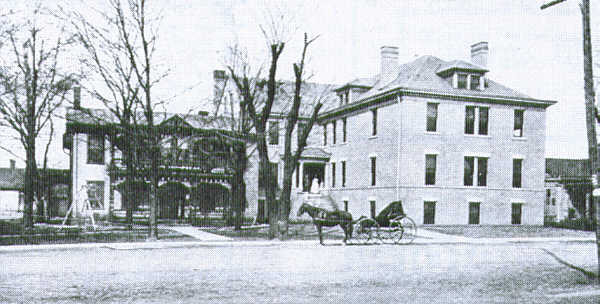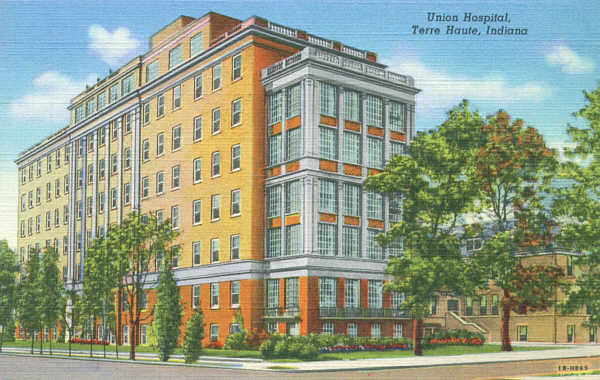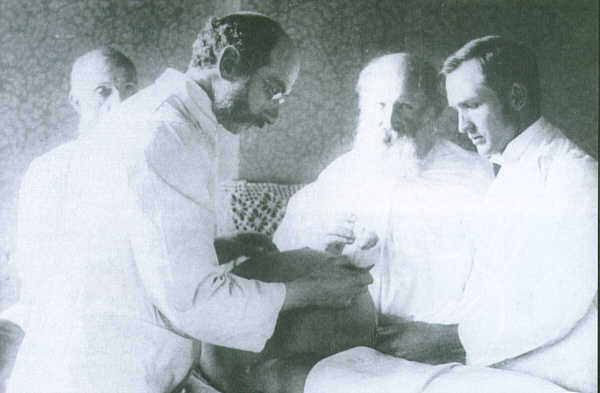
Terre Haute - A history and a guide
This is my history and guide to my adopted home - Terre Haute, Indiana.
Union hospital
Terre Haute has a fine medical establishment, with many specialized clinics for chiropracty, MRIs, physiotherapy and so on. It also has two fine hospitals, Union and Regional. This is the story of Union Hospital.
By 1892, Terre Haute was a thriving city and it was becoming apparent that the only hospital, St. Anthony's, could not keep pace with the increasing demand for medical services. One respected doctor, Leo J. Weinstein, had thoughts about establishing another hospital but was having trouble convincing his friend and colleague, Dr. Benjamin Franklin Swafford, to join him in the endeavor.
Dr. Swafford, however, changed his mind when one afternoon a driver jumped off his wagon and burst into the doctor's office, explaining he had no friends in town and his wife was about to give birth.

St. Anthony's Hospital - date unknown
Because St. Anthony's would not accept maternity cases, Dr. Swafford cared for the woman in his office. It was then that he decided that Terre Haute must have a hospital to accommodate maternities. Consequently, he and Dr. Weinstein opened the 20-bed Terre Haute Sanitarium in a two-story house on the corner of North Seventh Street and Eighth Avenue in 1892. The first patient was admitted on 11th August.
The hospital has seen many changed, both in name and structure. In 1895 the Terre Haute Sanitarium became the Union Home for the Invalids. In 1899 it was changed again to the C. W. Williams Union Hospital of Terre Haute. Then in 1906, it was finally changed to simply Union Hospital.
The original building was made of wood and the first brick building was erected in 1902. The old wooden building was demolished in 1909 but an extension was built to the brick building. Between 1922 and 1928 a new south wing was added, this is the building pictured in the colour postcard below, raising the capacity to 188 beds. The building did not take 6 years to build, what happened was that on completion the first two floors were equipped and the other floors followed as more funds became available. In 1953 the north wing was added, the south wing remodeled and the hospital boasted 219 beds.
By 1992 had room for 343 beds and employed 1,800 people handling 40,000 emergency room visits, 11,587 inpatient visits, 158,000 outpatient visits and 1,700 births annually.

Union Hospital - 1906
Image from Wabash Valley Magazine September/October 1992

Union Hospital - date unknown, but the older building is to the right
These old buildings were demolished in 2004. But the same year, the new buildings employed 2,103 people handling 42,643 emergency room visits, 13,309 inpatient visits, 319,014 outpatient visits and 1,425 births.
Between 1952 and 1965 the hospital administrator was Mrs. Ellen Church Marshall. She's interesting because in 1930 she was the world's first airline stewardess after convincing United Air Lines of the feasibility of using women as hostesses.
Both Dr. Swafford and Dr. Weinstein , the founders of Union Hospital, were leaders of their times and both were self-made men.
Benjamin Franklin Swafford was born Feb. 24, 1833, and moved to the area from North Carolina when he was 6. By the age of 13, due to the deaths of his parents and grandparents, he was on his own. Education was very important to the young Swafford and he made sure he received a thorough education. After teaching school for 30 months, he began studying medicine in a doctor's office in Paris, Illinois. In 1856, he graduated with full honors from Rush Medical College in Chicago, one of the finest schools of its kind, and returned to practice in New Goshen in 1858.
Although he was born in the South, Swafford was opposed to slavery and made the first war speech in Vigo County, calling for the Union's entrance into the Civil War. At the outset of the conflict, he enlisted in the militia and served as surgeon of the 11th Indiana Calvary from the time the regiment took up arms until the war ended.
He was in attendance in a number of ferocious battles and experienced some narrow escapes. He served during the Battle of Nashville (Tennessee) in which about 75,000 soldiers met on the battlefield. Following the Union's Tennessee campaign, Dr. Swafford was in charge of Field Hospital No. 11 in Eastport, Miss. In 1880, it was written:
The doctor is probably one of the most skillful surgeons in the state (Maryland), his long military service affording him abundant opportunity for perfecting himself in that branch of the profession.
Dr. Swafford returned to New Goshen following the war and practiced there until 1874 when he moved to Terre Haute and immediately became one of the town's leading citizens. He organized the Tri-State Medical Society that year and was its first president. In addition to medicine, Dr. Swafford was a polished speaker and delivered many speeches. He also served terms on the city and county councils and was twice nominated for state senator, which he turned down. Following is a description of Dr. Swafford by his colleague, Dr. Weinstein:
He was stern yet kind and charitable to his patients. He was short of stature and broad of beam and an inveterate pipe smoker. The curved stem of his pipe lay in the spread of his full, white beard, yellow-stained from nicotine. His vest, usually the worse from his salivary, artillery fire, covered a generous kris kringle belly and his office at 609 Poplar St. was heated with a stove and he would sit in a big arm chair, his feet on another chair, smoking his pipe and expectorating in the general direction of the stove. He had a large practice with many prominent and loyal patients.
Dr. Swafford died on January 8, 1901.
Leo Joseph Weinstein was born in Cincinnati on Jan. 19, 1848, his parents both immigrants. His father was from Poland and his mother from Germany.
From the age of 6 until he was 9, he worked in the glass works in Covington, Kentucky, and while employed learned to read. Like Swafford, young Weinsten was left alone at an early age, 11. He was employed in a store in Dayton, Ohio, until 1863, and later in a clothing store. Again, like Swafford, Weinstein attended Rush Medical College, then practiced in Cisco, Illinois, until graduating as an M.D. in Cincinnati in 1874.
Dr. Weinstein moved to Terre Haute in 1878 and held many offices in the city during his years here. He and Dr. Willien were the first doctors in Terre Haute to specialize in gynecology. He even traveled the town and countryside carrying a collapsible steel operating table.
It was written Weinstein "was kind and helpful to young doctors, was a conscientious public servant and a most skillful gynecologist." He died February 17, 1909.

Doctors perform a tumor operation at Terre Haute Sanitarium in 1893
(L-R) - S. J. Young, Leo J. Weinstein, Benjamin Franklin Swafford, W. E. Bell
Image from Wabash Valley Magazine September/October 1992
Sources :-
Terre Haute Journal of Business, February
2005 - Union sets Priorities for Vacant Space by Robert L. Flott
Vigo County Historical Society -
History of Terre Haute
Union Hospital History
Wabash Valley Magazine, September/October 1992 - Union Hospital Founders had Colorful Past by Rex Buntain
Wabash Valley Magazine, September/October 1992 - Union Hospital Turns 100 by Kelly Porter
This page created 9th March 2005, last modified 23rd February 2008